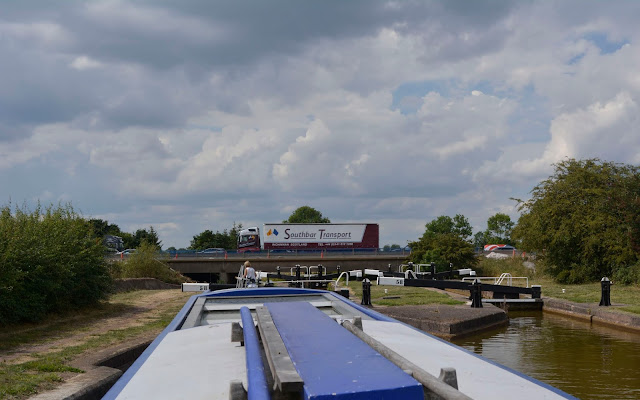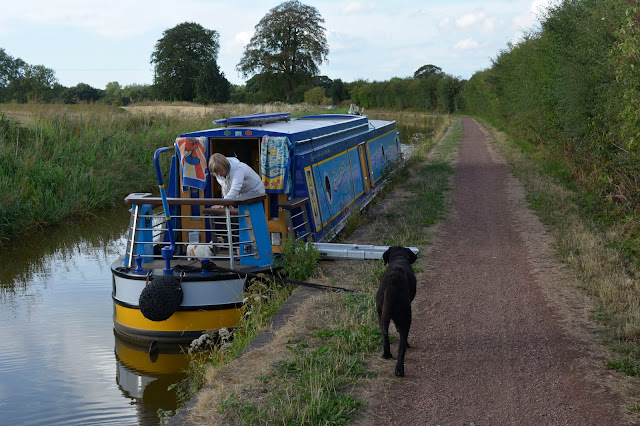Loulie took me down to the marina and we loaded various stuff onto the boat, then she went back home for the dogs. I took the boat out - it all went well at first, as I reversed out of our mooring neatly without fouling any other boats. I was pleased, because it is pretty tight. However, as I went forward and turned towards the exit I misjudged the curve as the wind pushed me towards the piers, and bumped against the stern of a boat before I could get away. It could have been worse, stuck on a lee shore, but I need to allow more room for windage in future. Most of the canal network is fairly sheltered, with trees and cuttings, but the marina is a large open space and the wind has more chance to make itself felt.
After that it all went fine, as I left the marina and turned north on the main line. I picked up Loulie and the dogs at Keckwick Lane bridge, and we headed out. We had no very firm plan, basically just head for Lymm and see how far we got before we needed to moor. We also wanted to get a feel for how long it would take to get to various landmarks. As it turns out we got to Grappenhall in two hours, and Thelwall (where we moor for the Little Manor) in two and a half. Loulie took the helm for a while on the approach to Lymm, but handed it back to me for the tricky bit through the middle, with boats moored on both sides.
It took us about three hours to get to Lymm, and on the other side we stopped to feed the dogs, and give them a walk. After I had picked up the crew we went on for a short while, past the Old Number Three, and moored close to Dunham Massey, just before the aqueduct over the river Bollin. Off the towpath there's a steep (but not dangerous) slope down to open rough ground - perfect for the dogs. It's an ideal mooring - we can just let them off, and the worst thing that can happen is that Minnie will go for a swim. We decided we should not feel we have to eat out every time we're on the boat, and so we just had spaghetti on board, rather than a meal at the Swan.
 |
Moored near Dunham Massey by the Bollin Aqueduct |
We were facing east, and we had to travel nearly two miles that way before we could find a winding hole and turn to come back. The bow thruster stopped working properly while we were winding - possibly there is something like weed blocking it. This and the wind which had got up gave me some concerns for mooring when we got back to the marina.
That was some distance away though, and we pottered slowly back the way we had come yesterday. We moored in Lymm to get some food, and the dogs had a walk, then we continued. There are a lot of day boats on hire on this stretch at the weekends, from Preston Brook, Stockton Heath and further afield, and they don't stick to the rules very well. You can usually spot them by the speed they are doing, and when I met one on a bend in Grappenhall he seemed to have forgotten which side to pass and tried to go down my starboard side. Fortunately he understood my frantic hand signals before we met with a crunch.
I dropped Loulie and the dogs at Keckwick Lane and carried on to the marina, with some trepidation. However it all went very well, despite the lack of bow thrusters. The trick is to take everything dead slow, and reverse and re-approach if necessary, rather than trying to do the whole thing in a dynamic swooping move. A narrowboat has no grip, and wind and the effect of banks and shallows mean that she doesn't always follow the line you are expecting. I lined her up carefully into our moorings, and slid slowly between the other boats without touching anything - very nice.
Voyage: 9 hours. 29.4 miles. 0 locks.
















































